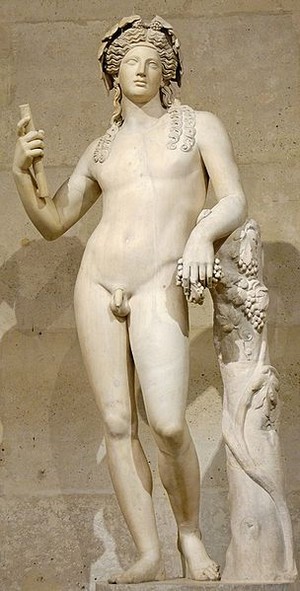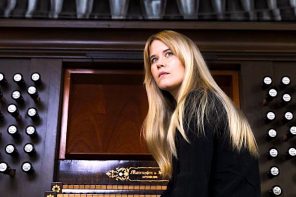Read all previous installments here, or better yet, never miss another feature by signing up for the RD Daily Newsletter here. You’ll receive our features and blogs every day in your inbox.
•
A mash-up of tropes and themes familiar from the biblical passion and apocalyptic sci-fi, A Star is Born and The Bacchae of Euripides, The Rise and Fall of Ziggy Stardust and the Spiders From Mars (1972) is thick with Christological symbolism and biblical allusions. Ziggy re-stages the rise and fall of Jesus Christ as a Pop-art comic strip—an Exploding Plastic Parable (with apologies to Warhol!) about the celebrity as demigod in a fame-crazed culture, where millions worship their idols onscreen (“praying to the light machine,” as Ziggy puts it) but would sacrifice them in a heartbeat—burnt offerings on the altar of Mark David Chapman psychopathy—for a shot at tabloid immortality.
Ziggy’s name, borrowed from a legendarily eccentric pop singer called The Legendary Stardust Cowboy, says it all. Like Jesus, who is “manifest in the flesh, justified in the Spirit” (1 Timothy 3:16), Ziggy is a walking paradox, what scholars of myth and religion call the coincidentia oppositorum (the conjunction of opposites that resolves all difference into a cosmic unity). He is, on one hand, “star” (that is, a celestial being like Jesus, who says in Revelation 22:16, “I am the bright Morning Star”) and on the other “dust” (mortal clay, as in Genesis 3:19, “for dust you are and to dust you will return,” the source text for The Book of Common Prayer’s graveside homily about “ashes to ashes” and the title, incidentally, of a 1980 Bowie song).
By outfitting his Martian messiah in campy, retro-futurist gear borrowed from the prop room of 1950s’ rocket-operas (“Keep your ‘lectric eye on me babe / Put your ray gun to my head,” Ziggy sings, in “Moonage Daydream”), Bowie provides enough ironic distance for us to see that all heavenly saviors are, by definition, space oddities: otherworldly beings who walk among us, passing as human; incorporeal body snatchers in mortal guise.
Ziggy arrives, as saviors always do, in humanity’s hour of need. “Earth is really dying,” a weeping newscaster reports, in “Five Years,” the album’s opening song; in just five years, the planetary ecosystem will experience an epic fail: “News had just come over, we had five years left to cry in.”
Like Christ, Ziggy spreads a radical gospel of love. But while Christ admonishes his followers to abandon the nasty, brutish logic of the Mosaic world view (“eye for eye, and tooth for tooth”)[1] and emulate his unconditional, turn-the-other-cheek love for all mankind (a message so revolutionary it convinces the apostle John that God, in a word, is love),[2] Ziggy preaches a gospel of transcendental eros. “Let all the children boogie,” he decrees, in “Starman,” using a mothballed hippie verb that, back in the day, was a euphemism for doing the nasty.[3]
In Ziggy’s erotic beatitude, the solitary self is consumed by an overmastering “idiot love”—a transport of sexual rapture that obliterates the boundaries of the conscious ego and “spark[s] the fusion,” in the song “Soul Love,” with…uh…the Cosmic Whatever. Is Ziggy’s space-hippie sermonizing about transcending adolescent alienation? Or hieing your astral ass off a dying planet through some orgasm-fueled transport of rapture? Bowie’s starman, a prophet who thinks with his crotch, isn’t big on specifics. All he knows is that “the church of man, love, is such a holy place to be,” a proverb that manages the neat trick of crossing eros with agape, reconciling them in the profane sacrament of soul love (“Moonage Daydream”).
Actually, Ziggy may be smarter than he knows. The art historian Partha Mitter reminds us that,
from a very early period in the history of Greek religious thought, earthly love was looked upon as a reflection of divine love…The mystic association between love and religion appeared early in Orphic rhapsodists, who saw no reason to differentiate between creation and procreation, for they were essentially two kinds of love, one cosmic and the other human.[4]
Mitter notes the influence of Orphic thought on Plato,
who often expressed profound spiritual ideas through sexual images [and who] saw a close relationship between erotic and religious impulses because for him love began in worship, but at the same time seeking a closer union with divinity. Plato, who believed that love regained the soul’s purity through the contemplation of beauty, uttered these remarkable lines in the Phaedrus: “Such as one, as soon as he beholds the beauty of this world, is reminded of true Beauty, and his wings begin to grow; then is he fain to lift his wings and fly upward.”[5]
Ziggy—a closet neo-Platonist?—reaches up through his loneliness to a “God on high” who, like Saint John’s, “is all love.” Ziggy, too, wants to lift his wings and fly upward, to “spark a fusion” with the divine—to “touch the flaming dove,” an image reminiscent of Plato’s but also lifted, intact, from Christian iconography, where the Holy Spirit appears as a dove, haloed by flames.
Ziggy is Christlike in other, equally roundabout ways. In “Moonage Daydream,” he boasts that he’s “a rock ‘n’ rollin’ bitch,” a “mama-papa coming for you”; in “Lady Stardust,” he slip-slides between genders, morphing into the ladyboy of the title. Ziggy’s twofold nature—gender-bending ladyboy, switch-hitting bisexual, “mama-papa” (an image recalling the freakshow hermaphrodite known as a half-and-half)—aligns him with the intersexed or androgynous deities of pre-Christian myth.
This archetype, which the historian of religion Mircea Eliade reads as a personification of the coincidentia oppositorum, wears a thousand mythic masks, most notably Phanes-Eros, the primeval creator-god of Orphic theology, who was both androgynous and bisexual;[6] Bacchus, identified in Orphic hymns as simultaneously male and female (and given the Lady Stardust-like epithet “Queen of Priapus” for good measure);[7] and Bacchus’s Greek alter ego Dionysus, a fertility god who tore fawns apart with his bare hands and whose emblem, paraded by his votaries, was the phallus but who was at the same time a beautiful, androgynous youth—“man-womanish” is the preferred adjective, in ancient sources—with effeminate curls, the proverbial wine-dark eyes, a fondness for crossdressing, and a weakness for swinging young shepherds.[8]
How does this underscore the leper messiah’s kinship with Jesus? Because Jesus, in the eyes of historians of religion such as Carl Kerenyi (Dionysos: Archetypal Image of Indestructible Life), shares cultural DNA with Dionysus. Some scholars believe the Dionysian mystery cult and early Christianity left a legible impress on each other’s traditions, and that the two religions fought for cultural dominance. Both Jesus and Dionysus embody the archetype of the god who dies and is reborn; both were begotten miraculously (Dionysus from his father Zeus’s thigh); both were honored with wine rituals consecrated to their resurrection; and both were ritually consumed by their worshippers, who believed that by symbolically ingesting their god they were communing with him. In Dionysus’s case, wine-maddened orgiasts tore a totemic animal such as a goat to pieces with their bare hands and devoured the bloody flesh raw; having drunk Dionysus’s blood and eaten his body (hello, Jesus), they surrendered themselves to frenzied ecstasies, possessed by the god (hello, spirit-filled Pentecostals.)
Whether Jesus is a lineal descendant of the Greek god or not, he is associated, like Dionysus, with a troublingly ambiguous relationship to gender (troubling, that is, for fundamentalists). In Mephistopheles and the Androgyne, Eliade traces a theological tradition stretching back to the Middle Ages, in which the prelapsarian Adam, born without sin, exists in a state of primordial perfection, reconciling both genders (the coincidentia oppositorum strikes again!). Medieval, and later Renaissance, theologians made much of Genesis 1:27 (“So God created man in his own image, in the image of God he created him; male and female he created them”), which mysteriously precedes Eve’s creation in Genesis 2:21. Likewise, Eliade points out, “several midrashim [early Jewish commentaries on biblical texts] represent Adam as having been androgynous,” contending that the first man “was a man on the left side, a woman on the right; but God split him in two halves.”[9]
Androgyne or hermaphrodite, Adam mirrored his creator: “In God there is no more division, for God is All and One,” writes Eliade.[10] Christ must necessarily reconcile the opposing genders, since he, as Yaweh, created Adam in his perfect image.[11] According to the fifth century theologian Maximus the Confessor, Eliade tells us,
Christ unified the sexes in his own nature, for in the Resurrection he was ‘neither man nor woman, though he was born and died a man.’[12]
He refers us to the eighth century theologian Johannes Scotus Erigena’s belief that the,
division into sexes was the result of sin, but it will come to an end in the reunification of man, which will be followed by the eschatological reunion of the circle of earth with Paradise. Christ has anticipated this final reintegration.[13]
German Romantics took this line of argument and ran with it, Eliade asserts—to Ziggy extremes. “For the German Romantics the androgyne was the type of the perfect man of the future. Ritter, a friend of Novalis, had sketched…a whole philosophy of the androgyne. For Ritter the man of the future would be, like Christ, an androgyne” (and, as a fringe benefit, immortal).[14]
Premonitions of Ziggy? Bowie’s song “Oh! You Pretty Things” (Hunky Dory) augurs the coming of a Nietzschean Overman, a glam-rock angel with Jesus genes who sounds a lot like Ritter’s man of the future:
Look at your children
See their faces in golden rays
Don’t kid yourself they belong to you
They’re the start of a coming race
The earth is a bitch
We’ve finished our news
Homo Sapiens have outgrown their use
All the strangers came today
And it looks as though they’re here to stay…
Oh! You Pretty Things
Let me make it plain
You gotta make way for the Homo Superior
In Part 7 we learn that rock fandom, taken to extremes, is indistinguishable from the ardor of enraptured believers like Saint Teresa of Ávila. Which is why some fans believe urban myths about a mass orgy at Ziggy’s 1973 farewell concert—holy communion in Bowie’s “Church of Man.”
_________________________
Notes:
1. Matthew 5: 38-9.
2. 1 John 4:8.
3. The third definition given for “boogie,” in The Concise New Partridge Dictionary of Slang and Unconventional English, ed. Tom Dalzell, Terry Victor (New York, NY: Routledge, 2008), is “to have sex, U.S., 1960.”
4. Partha Mitter, Much Maligned Monsters: A History of European Reactions to Indian Art (Chicago, IL: University of Chicago Press, 1992), p. 97.
5. Partha Mitter, Much Maligned Monsters: A History of European Reactions to Indian Art, ibid.
6. Mitter, Much Maligned Monsters, p. 98.
7. See Mitter, ibid., p. 99.
8. “Man-womanish”: Walter F. Otto, Dionysus: Myth and Cult (Bloomington, IN: Indiana University Press, 1995), p. 85. “Occasional shepherd”: When the shepherd Prosymnus died before Dionysus could make good his promise to bed him, the god satisfied his ghost by fashioning a dildo from an olive branch and pleasured himself by sitting on it—rather like those cane seats used by hunters, I like to imagine—astraddle Prosymnus’ tomb. We should all have such devoted mourners. Regrettably, some sources reject this tale as mere Christian libel, meant to discredit pagan beliefs.
9. Mircea Eliade, Mephistopheles and the Androgyne (New York, NY: Sheed and Ward, 1965), p. 104.
10. Mircea Eliade, Mephistopheles and the Androgyne, ibid.
11. Eliade, ibid.
12. Eliade, ibid.
13. Ibid.
14. Eliade, ibid., p. 101.





